This time, the Dwarves take center stage in the Lord of the Rings survival adventure Return to Moria – All info in this review/test
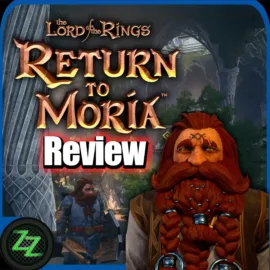
Underground Fantasy Survival
Lord of the Rings Style in the Test
Gimli and his clan of dwarves want Moria back and we dig our way through the deep mine, past goblins, wolves, orcs, and spiders. My review of the game with single-player and multi-player experiences. The Lord of the Rings: Return to Moria is a survival adventure in which we and up to eight dwarves in co-op multiplayer explore, survive, fight, discover, and build camps on our journey through the ancient dwarven realm.
Lord of the Rings: Return to Moria was released on October 24th, 2023 for Playstation PS5, and PC in the Epic Games Store, Xbox and Steam users will, unfortunately, have to wait until 2024.
This post is available as text and a YouTube Video (German Voice-Over, English Subtitles). So you can choose how you like to enjoy it most.
Lord of the Rings: Return to Moria Review Video
German Voice-Over, many subtitles
German Version:
- Lord of the Rings: Return to Moria Review Video
- Lord of the Rings: Return to Moria Review – Intro
- Background – Lord of the Rings franchise
- Game Type – Survival Adventure
- Gameplay – Story and Scope of the Game
- Lord of the Rings: Return to Moria Screenshots – Ingame Pictures (Part I)
- Gameplay – Character creation, Char Editor and Characters
- Crafting and Gathering
- Gameplay – Procedural Generated World
- Gameplay – Combat, Survival, and Exploration
- Tech, Graphics, Sound, Engine, Translation
- Lord of the Rings: Return to Moria Screenshots – Ingame Pictures (Part II)
- Lord of the Rings: Return to Moria Test – Opinion and Conclusion
- Return to Moria Review – Rating
- Outro
- Links and Sources
Lord of the Rings: Return to Moria Review – Intro

Your friendly Dwarf neighbor
Hello out there, Zap here. In this Return to Moria review, you’ll get a little insight into the new survival game featuring the dwarves from Lord of the Rings. I’ll tell you how it is played, what’s in it and at the end I’ll give you a rating. But above all, I want to give you all the information so that you can decide for yourself whether you might enjoy the game.
Return to Moria was developed by Free Range Games and published by North Beach Games. This studio has already worked on a few titles, including The Callisto Protocol, Oddworld Soulstorm, and Spelldriver. I received a free test key, thank you for that.
This shouldn’t affect my rating though, as I always test all games with the thought in mind of how I would feel if I had paid full price. However, to be able to test the multiplayer, which is very important for this type of game, we bought a second key, so it’s kind of half and half this time.
Background – Lord of the Rings franchise
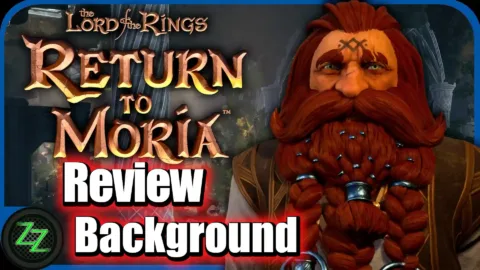
The Lords of the Rings Franchise
Lord of the Rings, is the epic story of hobbits, elves, and Sauron, the most evil of all fantasy worlds. In addition to the books and the very successful films, there are now also TV series. And more spin-offs are being planned.
There have also been numerous adaptations of the stories as computer games. Already on the C64 and Amiga, but also for PC and consoles, there were many examples of sometimes quite passable games, but also some real cranks, with the label of the fantasy saga by J.R.R. Tolkien.
Just this year, after long announcements and all kinds of expectations, Gollum was released, developed by the German Daedalic Studio. And this game flopped so dramatically that it was well on its way to being voted the worst game of the year. But now a weird King Kong spin-off successfully vied for this position.
There is a relatively successful MMORPG called Lord of the Rings Online that has been holding its own on the market for 16 years. Amazon is also currently having a new online game in the Lord of the Rings universe developed in-house by the creators of the reasonably passable New World MMO. Given the Gollum debacle, I was a little skeptical about Return to Moria at first.
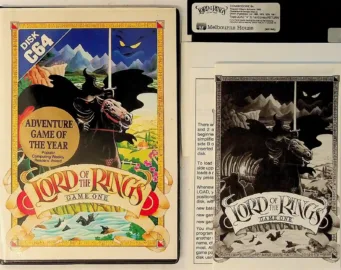
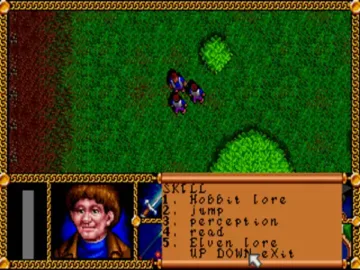
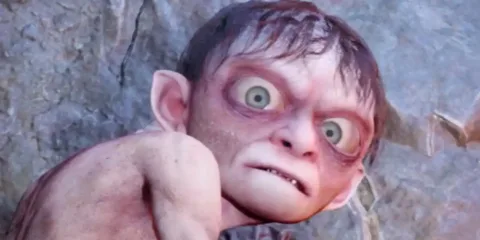
So now comes Return to Moria, offering a completely different insight into the world of Tolkien, from the point of view of the dwarves. With the studio behind Callisto Protocol, it was somehow a little more likely that Moria could become something. Return to Moria was released on 10/24/2023 for PlayStation PS5 and PC on the Epic Games Store. Xbox and Steam-only players will unfortunately have to wait until 2024.
Game Type – Survival Adventure

Game Type – Survival Adventure
We are a dwarf, or a whole troop of up to eight dwarves in multi-player, and try to recapture the legendary mines of Moria. Orcs, goblins, rats, wargs, and many other dangers lurk in the depths and some ancient treasures and secrets await us.
We start as a rather inexperienced young dwarf, with no equipment, no knowledge of tools, weapons, armor forging, or cooking. As in any other survival game, we then gradually work our way through a so-called tech tree, i.e. a sequence of specific techniques.
We build a torch from sticks, then a pickaxe with stones and cloth, at some point we can mine ores, learn to smelt them, and forge them. As we progress, new materials and new building parts, tools, weapons, and armor are added.
In most survival games, it’s more a case of one or a few base buildings that you keep expanding, defending, and upgrading. Moria, on the other hand, is more of an evolving adventure. We experience the journey through a very hostile area, the old mines of Moria, and search for an exit, a way through the mountain, for this purpose we also build camps to secure our journey.
So you keep building new camps and gradually secure the surrounding territory. Once you have achieved this, you can scout out the next campsite, clear it, build it up, and then travel on again. The old camps often lose their importance in the process. But I’ll tell you more about that later.
Gameplay – Story and Scope of the Game
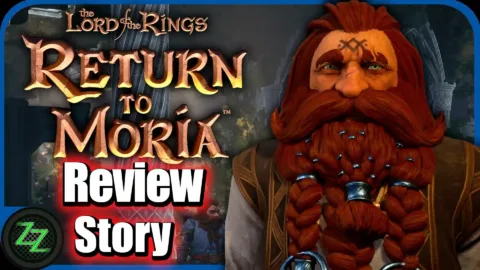
Story and Scope of the game
The dwarves want the ancient dwarven city of Moria back. Gimli himself is planning the reconquest in his old days. After being locked out of their home of Moria for a millennium, driven out by orcs, goblins, and the Balrog, they finally want to return.
But in addition to the familiar dangers, other problems stand in their way. The doors can no longer be opened with Mellum. And when they try to blow them up, there is a cave-in and we, the dwarves, get lost in the mountain.
We play this dwarf, either in solo play or together as a co-op experience with friends. So we have to survive in the old mine, explore it, and try to find another exit. Because the normal gates are sealed with a strange shadow curse. Maybe we can also find out how this happened and who is responsible.
We dig our way through the mountain and get deeper and deeper all the time. As befits survival-based games, we gradually explore new materials and recipes. We progress from iron and wood scraps to steel and elven wood until we can mine mithril and other rare ores, woods, and types of rock.
We travel through the mine, often exploring very stylishly designed locations and many dark tunnels. Everything is filled with goblins, half-orcs, orcs but also lots of wild animals such as wild boars, wolves, bears, spiders, elven stags, and bats. Boss battles with really big opponents will also follow later on.
The aim of the game is to find another exit on the eastern side of the mountains. But even after more than 20 hours of testing, our little band of dwarves is still a long way off.
It doesn’t look like we’re even halfway through the journey. So I suspect that it will easily take 80-100 hours or even more before we can reach an exit again at some point. But I don’t have any more precise information on this at the moment.
In contrast to many other survival games, Moria offers a brief storyline, which you experience in part through conversations with an Erebor raven. In addition, there are numerous texts to be found, writing tablets, and notes, and you can also experience some small stories through the voice output when you overhear the orcs. There are also small allusions to Gandalf, the Hobbit companions, or other characters from the books and films.
Lord of the Rings: Return to Moria Screenshots – Ingame Pictures (Part I)
Click or tap on the image for a larger view.
In the enlarged view, you can scroll right and left on the edges
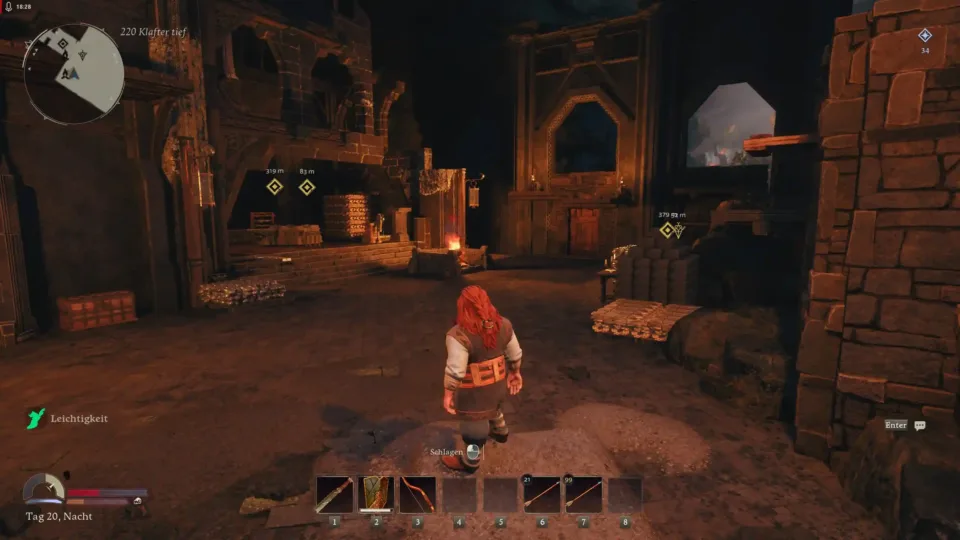
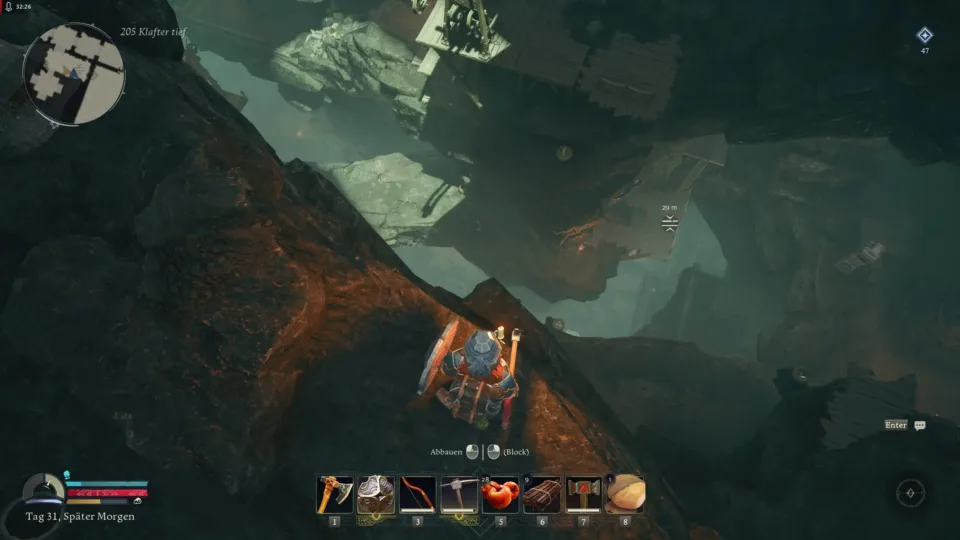

Vaults of the elven quarter
Gameplay – Character creation, Char Editor and Characters
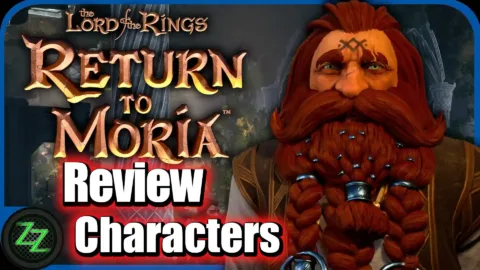
Character creation, Char Editor and Characters
In the beginning, there is extensive customization for our personal dwarf. We don’t have to specify a gender, but we are given the opportunity to customize our dwarf with or without a bust, body proportions, and beards as we wish. In the end, there are actually all forms of dwarf life, whether female, male, or diverse, it doesn’t make much difference. Every form of dwarf life has equal rights.
The character editor offers an extensive range of faces, hairstyles, beards, tattoos, and decorations. Many of the details can be colored in numerous variations. There are 8 different voices to choose from for the voice output and dwarven singing.
Overall, the figures look okay. They are not the prettiest dwarves, but the editor offers a good selection for individualization and personal style.
Sadly, there are no character values in Return to Moria. So there are no choices here, no RPG systems, etc. And we won’t be able to learn anything new directly later on either. The progress our dwarves make consists purely of knowledge about ores, their equipment, and the selection in the recipe book when crafting.
And this progress is always linked to the world, not to the individual dwarf. We can take our character from one world to another, and all items are retained. But the progress in the research tree, if you want to call it that, remains in the save game, not on the character.
Crafting and Gathering
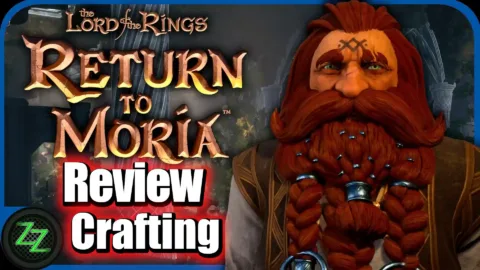
Crafting and Gathering
There are tons of things to loot and collect. We start with scraps of wood and build a torch from them. Add a bit of cloth and stones and we have a makeshift dwarf pickaxe.
We can use it to hack our way through earth walls, which are not very atmospherically distributed between the sections. Later on, there are also ore deposits and remnants of the old dwarf people, such as barrels, carts, and broken buildings. We can chop some of these up to obtain building materials.
On the way, the dwarves can build makeshift wooden platforms, for example, to reach higher ground or cross a small chasm. But for most structures, we first need to set up a camp, which initially requires a broken fireplace that we can find and repair.
If we have more materials and, above all, coal available, we can also build such fireplaces ourselves and set up a camp anywhere if we want to.
In a camp, we then have various walls, doors, windows, and floors at our disposal to build our very own dwarf home. There are also numerous workbenches where we can cook, refine materials, and produce new equipment or food.
Later in the game, there is also rune magic, travel stones, and other such complex things to research and build. And almost every new material we discover brings with it new recipes, so we expand our options more and more the deeper we go into the mountain.
Gameplay – Procedural Generated World
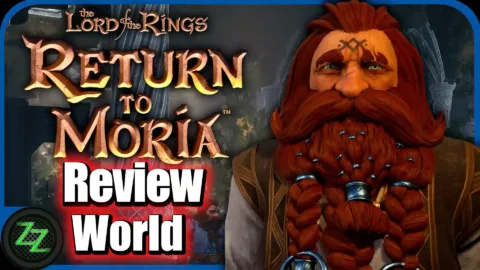
Procedural Generated World
Moria works with a procedural world generation system, i.e. a random generator assembles a world from a construction kit of prepared pieces, which can look different every time the game is started. Well, at least in theory, and this is partly how it is done.
As is so often the case with such systems, the world only becomes interesting for repeated play if there are enough components in this storage box from which the random system can take parts. Unfortunately, that doesn’t seem to be the case here.
The game is divided into individual sections. In the beginning, there is a fixed entrance where the tutorial takes place, which is always exactly the same. This is followed by a smaller section where you can get to grips with iron tools. At some point, you dig your way toward the mines, where you learn about steel and how to make tools and weapons from it.
But the main locations are always fixed places, only the corridors in between seem to be randomly generated. And this unfortunately creates a problem for the replay value. Because on the second playthrough, the layout and paths are slightly different, but the main locations are exactly the same. I think that can cause a motivation problem, at the latest the third time around.
Normally you can restart many survival games without any problems and start with a very different world, and this often results in very different gameplay and a new search for individual things. This is apparently not the case in Moria, which is a clear minus. But these fixed locations are really special and unusually designed, which is a plus again.
Gameplay – Combat, Survival, and Exploration
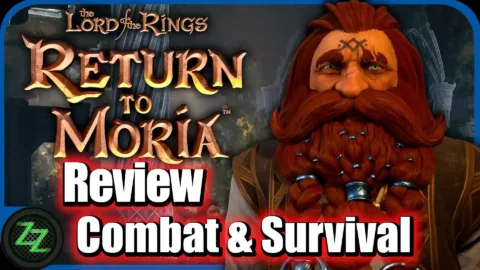
Combat, Survival, and Exploration
Our dwarves get hungry when they don’t eat enough. They get tired, and even if they are not afraid of the dark, there is an additional gloom in Moria that can frighten them. If you even enter haunted areas, you will be cursed for a longer period of time.
However, if we are well rested, we get a motivation buff and some food is particularly filling. We often have buffs and debuffs on us that can make our miners stronger or weaker. Later on in the game, we can brew beer and craft complex food to prepare our dwarves for the really tough challenges.
The mines are not without combat
Moria is a very combat-heavy game. Not only when advancing into new areas are there camps of goblins or orcs to conquer, we are also plagued by guard patrols and randomly passing beasts. These are usually groups of several enemies who like to surround you and try to attack from behind or push you into a corner. Sometimes there are coordinated attacks and sieges by larger groups on our camps, which we should therefore protect well.
In the course of the quest, there may even be horde attacks, with dozens of enemies charging at us at the same time. An equally impressive and potentially frightening situation. Moria is therefore not a game for pure, peaceful building. There are no setting options for difficulty levels, attack frequencies, or anything else. You can’t avoid fighting in Moria.
But if we die, it’s no great loss. We respawn at our last bound bed and that’s all that happens. Similar to Ark or Valheim, our equipment and the contents of our inventory lie in a tombstone at the place of our death. If we collect it, we get everything back.
Without stamina, there are not many options left
The combat system itself is stamina-based, meaning that every sprint, every block, every dodge roll, and every strike costs stamina. And if this drops to zero, we are almost defenseless for the time being and the best we can do is walk away. But we should be careful with this because attacks to the back cause extra damage. But of course, stamina regenerates relatively quickly if we do nothing for a moment. You can also hide behind a shield.
There are no healing potions, at least for the first 20–30 hours. Smaller food items only fill up our hunger bar but do not provide recovery. We can craft meals in the camp, which restores our health. But we can’t take this food with us, only eat it directly from the food table.
There are also complex food items to be found that fill you up, can heal you, and can be carried. But at least at the beginning, these are not available as craftable food. So if we are injured, we have to go back to the camp.
Equipment needs to be repaired, and armor especially often
Our equipment wears out and needs to be repaired at a repair shop, otherwise, it becomes unusable. This is especially true for all pieces of armor. The armor that we put on creates an additional blue bar above our life bar. And if we get into a fight, hits are first deducted from our armor bar. After that, it’s down to real life.
However, once the armor bar is gone, this also means that the armor is broken. And we have to repair it again in the camp, which also consumes material. This means that we have to plan very carefully when and where we put ourselves in danger and risk getting into fights. Because far away from the camp, it can be extremely dangerous if we don’t make it back alive.
This mechanic gives the fights a special thrill and makes blocking and dodging extremely important. Avoided damage is no problem for armor and life, but every hit ultimately shortens our travel range and forces us back to camp sooner.
There is a quest line that roughly guides you in a certain direction in which you should advance. However, you often come up against tough enemies and requirements for which you first need better equipment. And due to the camp mechanics and repair, it is always necessary to have a well-developed home somewhere nearby.
This is how you make your way tactically through the mines. Explore the area from a safe base, destroy enemy camps, slowly feel your way forward, and then at some point set up a new camp further ahead. Then start all over again. At least at the beginning, you gradually carry everything from the rear camps to the front line, but later there is also a fast travel system that makes this a little more pleasant.
Tech, Graphics, Sound, Engine, Translation
Moria is based on the Unreal Engine, which ensures stable gameplay as far as possible. I didn’t have a single crash during my tests, and neither did my partner, who tested the game with me.
The graphics offer a medium-quality level of textures and quite good lighting, and often Moria manages to create a very chic ambiance. In the darker sections, there are sometimes even some creepy moments.
The soundtrack is upper middle class. The sounds in the caves and the battle sounds are okay. There is some voice output, the quality of which is also between okay and good. We had a bug in the test that in multiplayer all dwarves always spoke with the voice of the host dwarf. This was irritating because the male dwarves had female voices, but in the end, it wasn’t really dramatic. I hope this will be fixed.
The on-screen texts are available in a total of eight languages. There are German texts for tooltips and numerous books, text panels, tutorial texts, etc.. But the voice output is in English or mixed with actual dwarven if that’s what you choose when you create your character.
Lord of the Rings: Return to Moria Screenshots – Ingame Pictures (Part II)
Click or tap on the image for a larger view.
In the enlarged view, you can scroll right and left on the edges
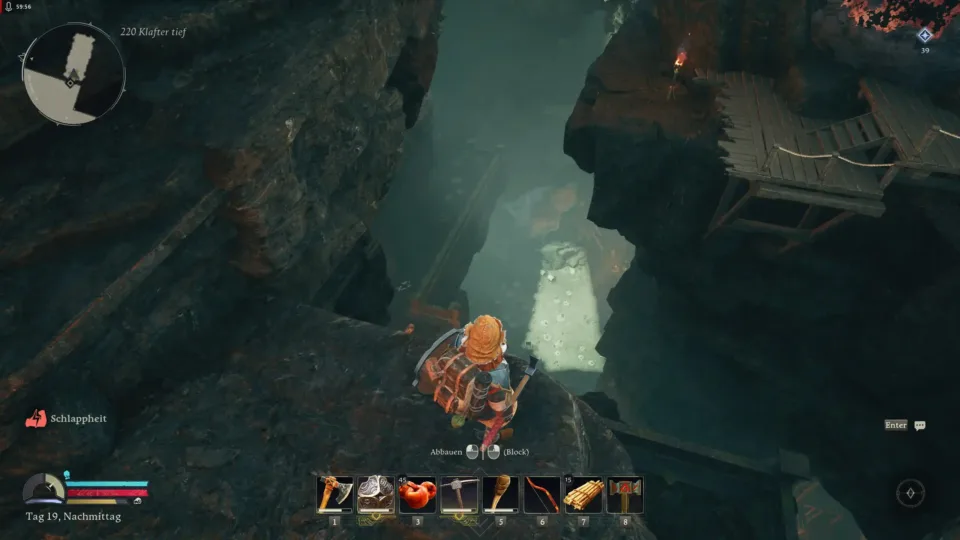
deep, deep mines
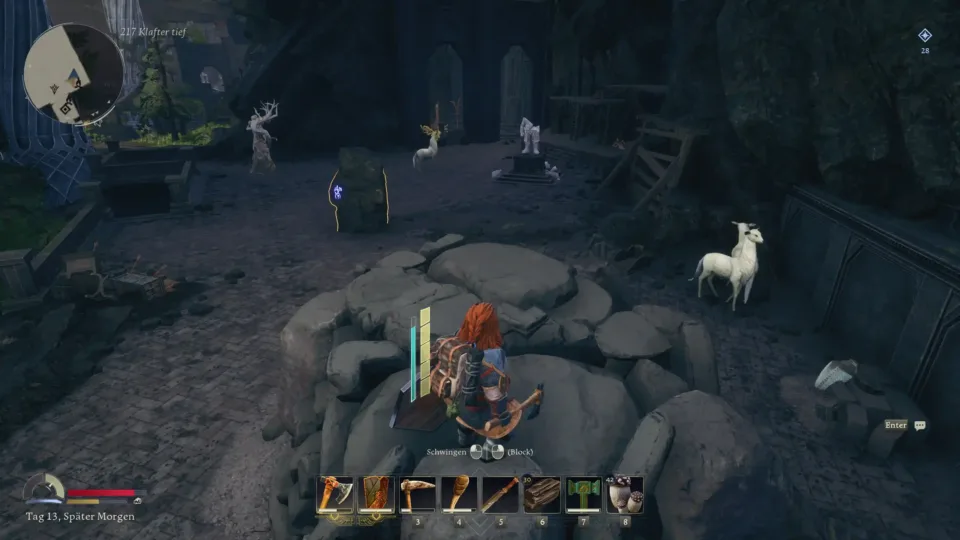
Elven deer
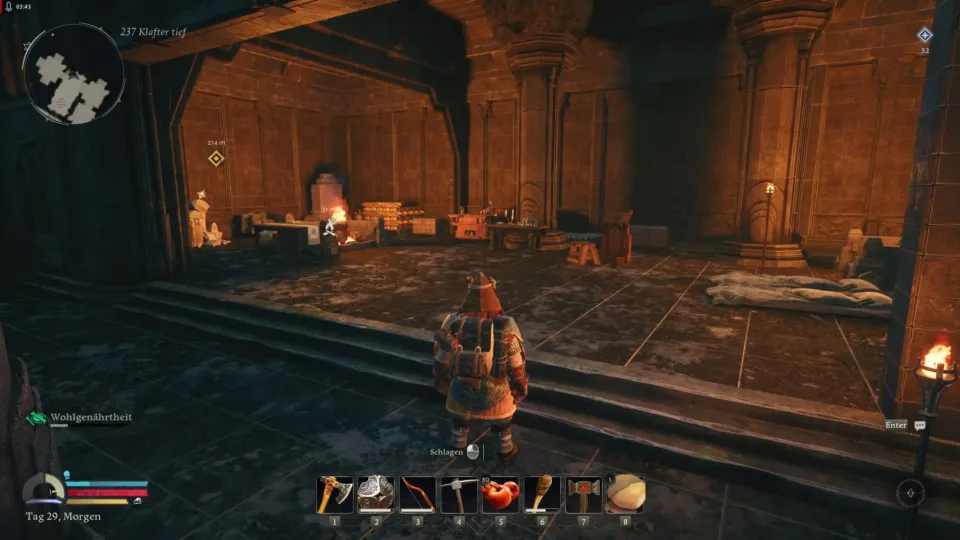
Make a secure base to proceed deeper in the mines

Lord of the Rings: Return to Moria Test – Opinion and Conclusion
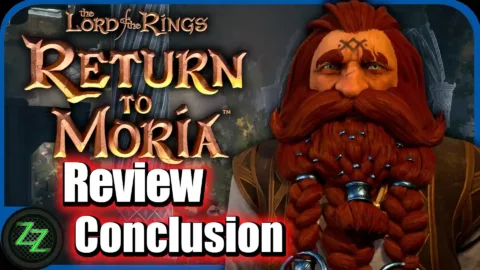
Opinion and Conclusion
At first glance, Return to Moria looks a little old-fashioned, but when you walk around in it, this quickly disappears. In the course of the story, you will find elven caves or old dwarven mines, where everything is oozing and dripping with ambiance, making the graphics look really pretty.
The combat controls are sometimes a little imprecise and the hit feedback lacks a little polish. But the fighting is actually well done and fun. It’s only when you’re under siege or attacked by a horde that the number of enemies can be a bit overwhelming. If you are more of a pacifist and don’t feel like fighting, Moria may not be the right game for you, nor if you have a phobia of spiders.
The lack of RPG systems leaves me a bit disappointed
One problem area in my eyes is that the entire character development actually consists only of recipes and crafted equipment. There is no skill system, no character values that could somehow increase or that could be improved or upgraded by anything. New weapons make you stronger, new armor a little more resistant, but that’s pretty much it.
And RPG systems or decisions in character development are completely absent in this game. Moria really wastes a lot of potential here, which I think is a shame. With an exp system, level-ups, and a few skills, increasing life energy or less stamina consumption through practice, the game could have been upgraded a lot more.
The unusual system with the armor, which only protects once and then has to be repaired, really irritated me at first, but it got better over time. Ultimately, this always gives exploration and combat a special thrill that is less common in games with healing potions and regeneration between battles. Moria is very different here, but that’s not a bad thing.
The design of the world is remarkable, at least later on
I really liked the design of the world. At first, it seems a bit simplistic and box-based, but once you get into the actual mines, the world gradually opens up and the level design becomes very three-dimensional and much more complex than it seems in the first few hours. There are some really beautiful places, some special features that can only be discovered if you really search every corner. Apart from that, Moria offers all kinds of game features and experiences that you wouldn’t normally expect in survival games.
Building consists of the steps of selecting a recipe from the building menu and determining where it should be placed. Once you have the necessary resources, it goes boom and the item is completed, without any special animations. That could have been done better.
In Moria, the construction of extensive buildings and, above all, to build beautiful are not that prominent. It’s more about having a defense and a safe retreat in a very hostile world than in comparable games such as Valheim, Ark, or similar games. There you often hang on to a base for a very long time and make it prettier and prettier. This is less the case here because you actually have to travel further. But the option exists, and perhaps you expand it anyway simply for the love of building.
After the Gollum debacle, Return to Moria is a very positive experience
All in all, Return to Moria surprised me in a very positive way. As a Lord of the Rings fan, I really wanted to try it out. In addition, I have a particular soft spot for dwarves, in all computer or tabletop role-playing games where dwarves are available, I prefer to play dwarves. So a game just about the dwarves of Moria was a special thing for me.
But after the enormous disappointment of Gollum, I was very, very skeptical whether Moria could really be a good game. And lo and behold, yes, it is a good game. Not an extremely good one, but it is guaranteed to provide 30-50 hours of fun, and since it can also provide a good time together with a few friends in co-op play, it is doubly recommendable.
The price of €39.99 is a little higher than you’re used to from Valheim. But if you look at what some other survival titles cost, it’s more mid-range. So I tend to think, yes, Moria could be 10 euros cheaper, but it’s still okay. Presumably, the Lord of the Rings license simply costs a little more and the money has to be recouped somehow.
For some, it will be a hard blocker that Moria has only been released for Playstation and the Epic Games Store so far. But Steam and Xbox versions are also due to follow in early 2024, i.e. in a few months’ time. So a little patience, and then all gamers can descend into the depths in equal measure.
Return to Moria Review – Rating
If I summarize all of this, the result is a very positive picture for Return to Moria. I give it a base rating of 85% for the scope, the good gameplay, and the numerous possibilities in the game. All in all, it’s a well-rounded gaming experience, and, at least in the first playthrough, it offers plenty of depth (pun intended).
Since there were almost no bugs, I see no reason for a deduction here, but I do see problems with the replay value and for that, there is a 3% deduction. This brings me to a final rating of 82% for Return to Moria.
Unfortunately, I don’t know at the moment whether expansions, DLCs, or major updates are planned. But I think there’s a lot more to be made of it.
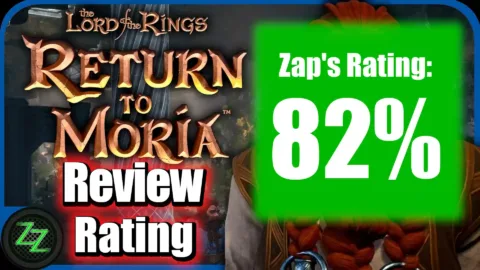
Rating with numbers – 82 percent
Lord of the Rings: Return to Moria
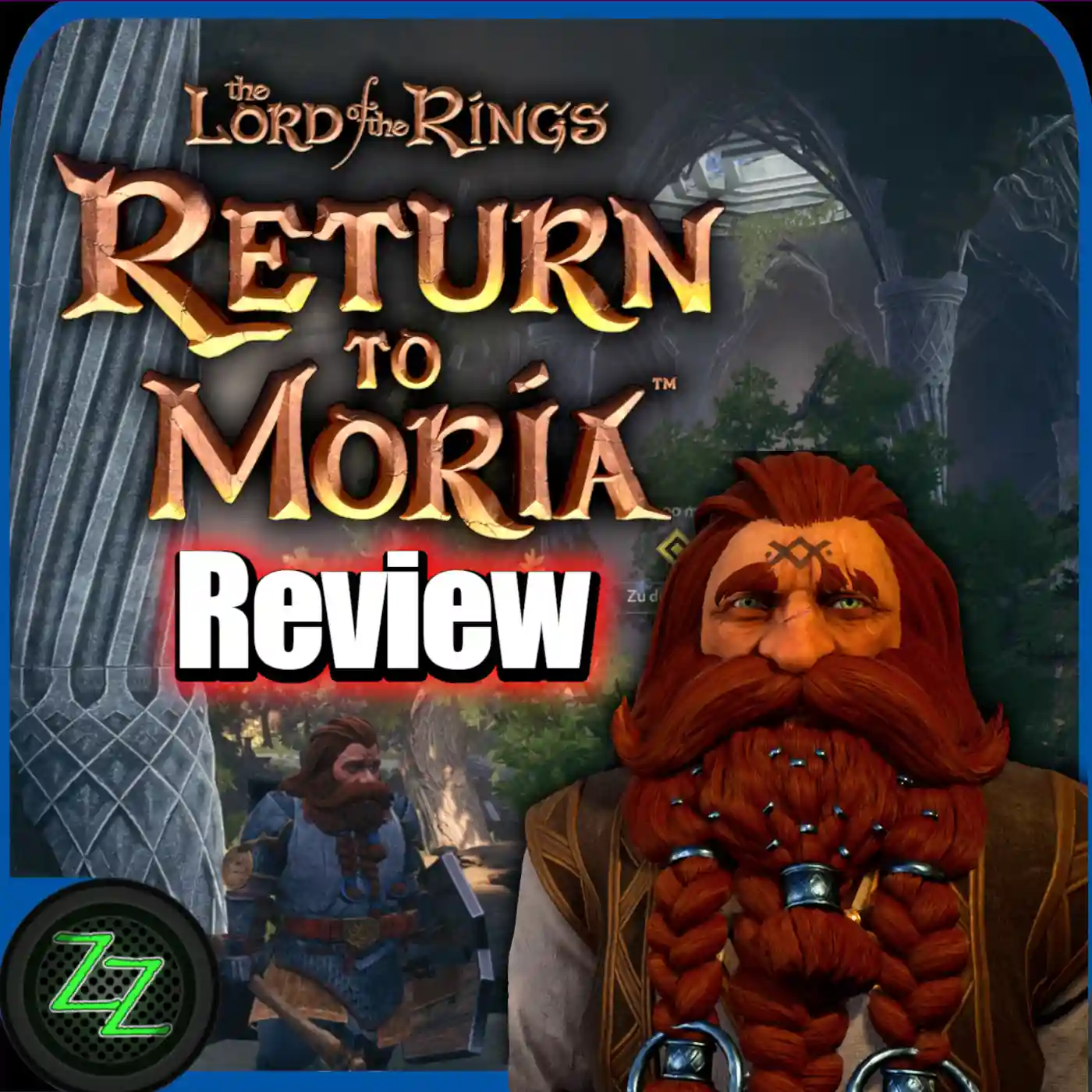
Gimli and his clan of dwarves want Moria back and we dig our way through the deep mine, past goblins, wolves, orcs, and spiders. My review of the game with single-player and multi-player experiences. The Lord of the Rings: Return to Moria is a survival adventure in which we and up to eight dwarves in co-op multiplayer explore, survive, fight, discover, and build camps on our journey through the ancient dwarven realm.
Rating
If I summarize all of this, the result is a very positive picture for Return to Moria. I give it a base rating of 85% for the scope, the good gameplay, and the numerous possibilities in the game. All in all, it’s a well-rounded gaming experience, and, at least in the first playthrough, it offers plenty of depth (pun intended).
Since there were almost no bugs, I see no reason for a deduction here, but I do see problems with the replay value and for that, there is a 3% deduction. This brings me to a final rating of 82% for Return to Moria.
Unfortunately, I don’t know at the moment whether expansions, DLCs, or major updates are planned. But I think there’s a lot more to be made of it.
Outro
Do you like being a dwarf, digging your way through Moria, and beating up orcs? Or are creepy mine tunnels and lots of battles no fun for you? Let me know what you think in the comments or in the Community Discord.
You can find more gaming news, game reviews, and guides on the YouTube channel or at https://zapzockt.de – click your thumbs, subscribe, and share with friends, and then I wish you a great day, ciao ciao, your Zap
Links and Sources
Buy Return to Moria at the Epic Games Store (Affiliate Link)


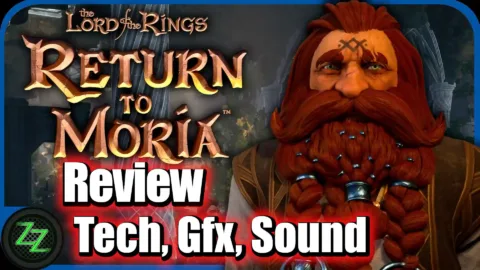

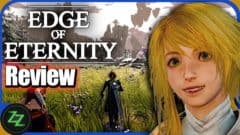
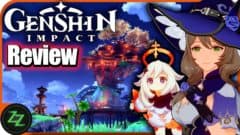

![Starfield Review - Bethesda's Space Role-Playing Game in the Test Starfield Review - Grandioses Space-RPG mit spitzen Ecken & harten Kanten im Test [PC Deutsch]](https://zapzockt.de/wp-content/uploads/Starfield-Review-Grandioses-Space-RPG-mit-spitzen-Ecken-harten-Kanten-im-Test-PC-Deutsch-240x135.webp)
